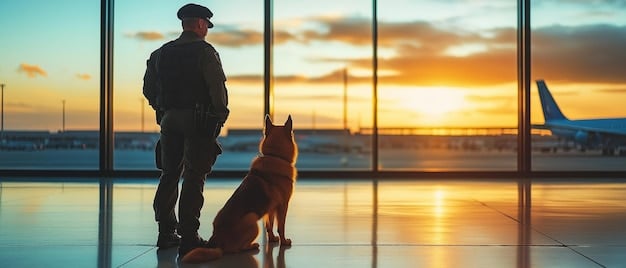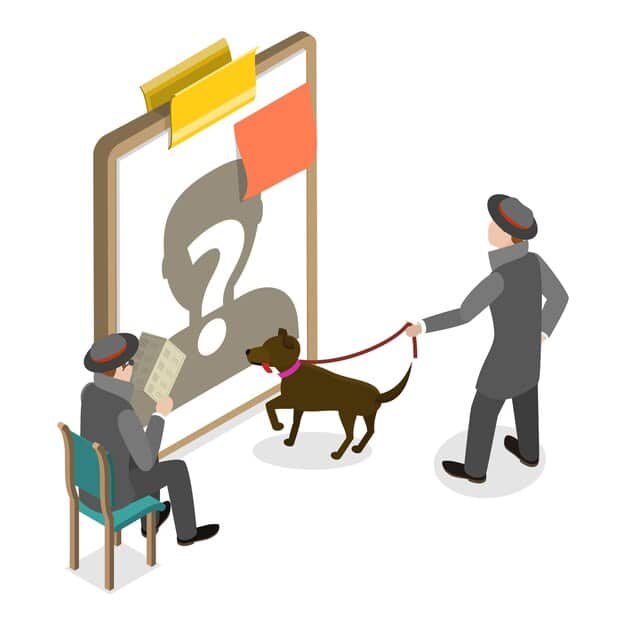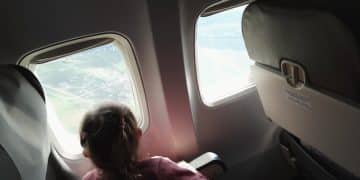New Regulations on Emotional Support Animals on US Flights Take Effect

The U.S. Department of Transportation has implemented significant new regulations regarding emotional support animals on flights, reclassifying them as pets and allowing airlines greater discretion in their accommodation, directly impacting air travelers and their companion animals as of January 2021.
For years, the presence of emotional support animals (ESAs) on U.S. flights has been a topic of much discussion, often balancing the needs of passengers with the operational realities of airlines. Today marks a significant turning point with breaking: new regulations on emotional support animals on US flights take effect, fundamentally altering the landscape for air travelers and their animal companions.
Understanding the Shift in ESA Regulations
The U.S. Department of Transportation (DOT) has finalized amendments to its Air Carrier Access Act (ACAA) regulations concerning the transportation of service animals. These changes, primarily aimed at curbing the rising incidents of untrained animals posing as ESAs, have effectively redefined what constitutes a service animal for air travel purposes.
Previously, emotional support animals were largely treated similarly to service animals, requiring airlines to accommodate them in the cabin without charge, provided certain documentation was presented. This led to a significant increase in the number and types of animals flying, prompting concerns from airlines and some passengers about safety, hygiene, and behavior.
The DOT’s Rationale for Change
The DOT’s decision was informed by a deluge of complaints from airlines, flight attendants, and passengers alike. These complaints ranged from reports of biting incidents and aggressive behavior to animals urinating or defecating in the cabin. The flexibility surrounding ESAs had, to some extent, been exploited, leading to a perception that the system was being abused.
- Addressing Misrepresentation: The primary goal was to prevent the misrepresentation of pets as service animals.
- Enhancing Safety: To improve safety for passengers and crew by ensuring animals on board are genuinely trained service animals.
- Clarifying Definitions: To provide greater clarity for airlines on their obligations and what documentation they can require.
The new rule tightens the definition of a service animal, specifically excluding emotional support animals. This means that airlines are no longer required to recognize ESAs as service animals, effectively allowing them to treat ESAs as pets, subject to their individual pet policies, which often include fees and size restrictions.
Key Provisions of the New Rule
The updated regulations define a service animal as a dog, regardless of breed or type, that is individually trained to do work or perform tasks for the benefit of a qualified individual with a disability. This narrow definition stands in stark contrast to the previous approach, which encompassed a broader range of definitions and species for ESAs.
Airlines can now require passengers traveling with service dogs to complete a DOT form attesting to the animal’s health, training, and behavior. Furthermore, airlines are permitted to require service dogs to be harnessed, leashed, or tethered at all times. They can also refuse transport to service animals that display aggressive behavior or pose a direct threat to the health or safety of others.
The introduction of these stringent rules means a significant adjustment for passengers who rely on emotional support animals for their well-being. It underscores a fundamental shift in how air travel accommodates diverse passenger needs, prioritizing a more universal standard for all travelers.
Impact on Travelers with Emotional Support Animals
For individuals who have previously traveled with their emotional support animals without issue, the new regulations present a considerable hurdle. The immediate consequence is that airlines are no longer compelled to permit ESAs in the cabin free of charge. This means that travelers will now likely face pet fees, size and breed restrictions, and potentially the requirement for their animal to travel in a cargo hold, depending on the airline’s specific policies.
Many travelers relied on their emotional support animals to alleviate anxiety, depression, or other emotional conditions during flights. The inability to have their ESA by their side could lead to increased stress and discomfort, potentially deterring some from air travel altogether. This shift necessitates a re-evaluation of travel plans and mental health strategies for these individuals.
Financial and Logistical Implications
The financial burden associated with traveling with an ESA will now increase significantly. Pet fees can range from tens to hundreds of dollars per flight, making air travel less accessible for many. Moreover, the logistics become more complex:
- Cage Requirements: Many airlines require pets to travel in FAA-approved carriers that fit under the seat or in the cargo hold.
- Breed Restrictions: Some airlines have breed-specific restrictions, particularly for brachycephalic (short-nosed) breeds, due to respiratory concerns.
- Veterinary Check-ups: Updated vaccination records and health certificates may be required, adding another layer of preparation.
For those whose ESAs are too large to fit under a seat, the option to travel in the cargo hold raises concerns about the animal’s safety and well-being, especially during long flights or in extreme temperatures. This places a difficult choice before pet owners who view their animals as integral to their emotional stability.

Adapting to the New Reality
Travelers accustomed to flying with ESAs will need to adapt their strategies. This could involve exploring alternative modes of transportation, seeking out airline policies that are more lenient towards pets (though these are becoming rarer), or considering whether their animal genuinely qualifies as a service dog under the strict new DOT guidelines. It also prompts a broader discussion within the disability community about the distinction between emotional support and the trained tasks performed by service animals.
The change also puts a spotlight on the importance of mental health support systems that do not solely rely on the physical presence of an animal during air travel. Passengers might need to consult their healthcare providers for alternative coping mechanisms or explore virtual support options to manage their conditions while flying.
Airlines’ Perspective: Benefits and Challenges
From the airlines’ perspective, these new regulations are largely seen as a welcome change, providing much-needed clarity and operational flexibility. For years, carriers navigated a complex and often contentious landscape regarding emotional support animals, facing challenges that ranged from safety concerns to disputes with passengers.
One of the most significant benefits for airlines is the ability to standardize their policies regarding animals on board. With ESAs now reclassified as pets, airlines can apply their existing pet transportation rules, which include size and weight restrictions, breed limitations, and associated fees. This eliminates the ambiguity that previously surrounded ESAs, reducing instances of conflict at the boarding gate and streamlining boarding processes.
Enhanced Safety and Operational Efficiency
The primary driver behind the airline industry’s push for these changes was safety. Reports of unruly or untrained animals causing disruptions, biting, or soiling cabins were becoming increasingly common. The new rule, by focusing strictly on trained service dogs, aims to mitigate these risks. Airlines can now:
- Decline unruly animals: Refuse transport to animals that exhibit aggressive behavior.
- Ensure proper containment: Require service dogs to be harnessed, leashed, or tethered.
- Reduce cabin incidents: Potentially lower the number of incidents involving untrained animals.
This also translates to improved operational efficiency. Flight crews and ground staff no longer need to spend extensive time adjudicating complex ESA documentation or dealing with passengers attempting to board with unusual animals. The clearer guidelines mean smoother operations and a more predictable environment for all on board.
Potential Challenges for Airlines
Despite the overall positive reception, airlines may still face some challenges. The new rules, while clearer, may not entirely eliminate disputes. Passengers might still attempt to present ESAs as service animals, leading to potential confrontations. Furthermore, airlines need to ensure their staff are thoroughly trained on the updated regulations, especially in distinguishing legitimate service animals from pets that do not meet the new criteria.
Another challenge could be managing public perception. While the DOT’s actions were aimed at addressing misuse, some passengers validly depend on emotional support animals. Airlines must be sensitive to these cases, even if they are no longer legally obligated to accommodate ESAs under the previous framework. This requires careful communication and understanding to avoid alienating a segment of their customer base.
Ultimately, the new regulations offer airlines a more consistent and manageable approach to animal transportation. They represent a significant win for industry stakeholders seeking greater control and predictability in air travel operations, while simultaneously aiming to preserve the integrity of legitimate service animal accommodations.
The Distinction: Service Animals vs. Emotional Support Animals
The new regulations critically hinge on a fundamental re-emphasis of the distinction between service animals and emotional support animals. Prior to these changes, the lines were often blurred, leading to confusion and, at times, abuse of the system. Now, the Department of Transportation has unequivocally clarified these roles within the context of air travel.
A service animal is defined by the Americans with Disabilities Act (ADA) and now, more specifically, by the DOT for air travel, as a dog that is individually trained to do work or perform tasks for the benefit of a qualified individual with a disability. These tasks must be directly related to the individual’s disability. Examples include guiding a person who is blind, alerting a person who is deaf, pulling a wheelchair, alerting and protecting a person who is having a seizure, or reminding a person with mental illness to take prescribed medications.
Key Differences Reaffirmed by DOT
The critical element for a service animal is the specialized training to perform specific tasks. This training is what distinguishes them from emotional support animals, which provide comfort through their presence but do not necessarily perform specific, trained tasks related to a disability. The DOT’s updated rule explicitly states:
- Training Requirement: Service animals must be individually trained to perform tasks. ESAs do not require this specific, task-oriented training.
- Species Limitation: For air travel, only dogs are recognized as service animals. This excludes other species previously identified as ESAs.
- Purpose: Service animals perform tasks that mitigate a disability. ESAs provide comfort, which is not considered a task under the new definition.
This clarification means that simply providing emotional comfort or companionship, while valuable, no longer qualifies an animal for specialized accommodation under the Air Carrier Access Act. The focus has shifted entirely to animals that are integral to a person’s ability to navigate their world due to a disability by performing specific, learned actions.

Consequences of the Reclassification
The reclassification of emotional support animals as pets has several implications. Primarily, it means that airlines are no longer required to accommodate ESAs free of charge in the cabin. Passengers with ESAs will now be subject to the airline’s standard pet policies, which may include:
Pet fees, restrictions on size, weight, and breed, and the requirement for animals to travel in carriers that fit under the seat or in the cargo hold. This stark difference underscores the DOT’s intent to reserve special accommodations for truly trained service animals, ensuring equity and clarity across the aviation industry. It is a critical distinction that all travelers and pet owners must now recognize when planning air travel.
Legal and Ethical Considerations
The new regulations on emotional support animals on U.S. flights have ignited a complex debate spanning legal validity and ethical implications. While the Department of Transportation (DOT) cites a need for safety and consistency, disability advocates and animal welfare organizations have raised concerns about the fairness and impact on individuals who genuinely benefit from the presence of their emotional support animals.
Legally, the DOT’s authority to amend the Air Carrier Access Act (ACAA) is derived from its mandate to ensure non-discrimination against individuals with disabilities in air travel. The department argues that the redefinition aligns with the intent of the ADA, which specifically defines service animals as those trained to perform tasks for disabled individuals. By narrowing the definition for air travel, the DOT aims to prevent further exploitation of the system while upholding access for those with legitimate service animals.
Concerns from Advocacy Groups
However, disability rights groups contend that while some abuse existed, the broad reclassification oversteps boundaries by potentially limiting access for individuals whose disabilities are genuinely mitigated by emotional support animals, even without specific task training. They argue that the emotional and psychological support provided by these animals is a critical component of their owners’ well-being, especially in stressful environments like air travel. Such groups emphasize:
- Mental Health Impact: The potential for increased anxiety and stress among travelers with conditions like PTSD or severe panic attacks who relied on ESAs.
- Accessibility: The effective reduction of accessibility for a subset of disabled individuals, creating a significant barrier to travel.
- Ethical Obligation: A moral and ethical obligation to accommodate diverse disability needs, transcending strict task-based definitions.
The debate touches on the nuanced understanding of disability itself – whether “tasks” must be overtly physical or can encompass psychological regulation that allows an individual to function. For many, an ESA’s calm presence is a preventative measure against a crisis, allowing them to travel independently and safely.
Balancing Rights and Practicalities
Ethically, the regulations pose a dilemma between the rights of the many passengers to a safe and predictable flight experience, and the needs of a smaller, vulnerable group. Airlines and regulators found themselves in a difficult position, attempting to balance these competing interests. The new rules reflect a lean towards operational realities and the prevention of misuse, potentially at the expense of individuals with genuine, but less tangible, needs.
This situation underscores the ongoing challenge of drafting legislation that is both effective in its intent and equitable in its application. It highlights the importance of continued dialogue between regulators, airlines, and disability rights advocates to explore solutions that uphold safety and accessibility without unduly burdening any party. The legal framework surrounding animal assistance is continually evolving, and these regulations are a significant milestone in that ongoing journey, prompting a re-evaluation of how society views and accommodates various forms of support for individuals with disabilities.
Preparing For Future Travel With Animals
With the new regulations firmly in place, travelers intending to fly with animals, whether service animals or pets, must adopt a proactive and informed approach. The era of casual travel with an “emotional support” designation is over, necessitating meticulous planning and adherence to strict guidelines to ensure a smooth journey for both human and animal.
The first and most crucial step is to understand the absolute distinction between a service animal and a pet under the new DOT rules. If your animal is a service dog—meaning it’s specifically trained to perform tasks for a person with a disability—you’ll need to familiarize yourself with the required DOT forms. These forms attest to the dog’s training, health, and behavior, and must be submitted to the airline in advance.
Essential Steps for Animal Travel
For those traveling with pets, including animals previously flying as ESAs, preparation is key. Each airline has its own pet policy, and these vary significantly. Passengers must:
- Check Airline Policies: Research your specific airline’s pet policy well in advance of booking, paying close attention to fees, size/weight limits, and whether the animal can fly in-cabin or cargo.
- Veterinary Consultation: Schedule a vet visit to ensure your animal is healthy for travel and to obtain all necessary health certificates and vaccination records. Some destinations and airlines have specific requirements, often needing to be completed within a tight timeframe before travel.
- Crate Training: If your pet needs to travel in a carrier, especially in the cargo hold, ensure it is IATA-compliant and that your animal is comfortable spending extended periods inside.
For larger animals or those that don’t meet in-cabin pet criteria, the cargo option comes with its own set of considerations, including temperature restrictions, layover logistics, and the animal’s comfort. It’s vital to assess if this is the best and safest option for your companion.
Alternative Travel Solutions and Resources
Given the complexities of air travel with animals, especially larger ones or those that previously flew as ESAs, it might be prudent to explore alternative travel solutions. For domestic trips, driving can often be a less stressful option for both pet and owner, offering flexibility and fewer restrictions. Trains and buses also have varying pet policies that may be more accommodating than airlines.
Numerous resources are available to help navigate this new landscape. Official DOT guidelines provide comprehensive details on service animal requirements, while individual airline websites detail pet policies. Various pet travel agencies and forums offer advice and support from experienced travelers. Staying informed and being prepared are the best defenses against potential travel disruptions, ensuring that future journeys with your animal companion are as seamless as possible under the new regulatory framework.
| Key Point | Brief Description |
|---|---|
| ✈️ ESA Reclassification | Emotional Support Animals are now largely treated as pets on US flights, reducing previous accommodations. |
| 🐕 Service Animal Definition | Only dogs specifically trained for disability-related tasks qualify as service animals under new DOT rules. |
| 💸 Increased Costs for Pets | Travelers with ESAs (now pets) will likely incur fees and adhere to airline pet policies. |
| 📋 DOT Forms Required | Passengers with service dogs must complete new DOT forms before flying. |
Frequently Asked Questions About New ESA Regulations
▼
The primary change is that emotional support animals are no longer recognized as service animals under the Air Carrier Access Act. Airlines are now permitted to treat them as regular pets, meaning they can charge fees, impose size/breed restrictions, and require them to travel in carriers or cargo, as per their standard pet policies.
▼
No, under the new regulations, airlines are no longer required to allow emotional support animals to fly in the cabin for free. Your emotional support animal will likely be subject to the airline’s standard pet policies, which often include fees, size limitations, and specific carrier requirements for in-cabin or cargo travel.
▼
A “service animal” is now defined as a dog, regardless of breed or type, that is individually trained to do work or perform tasks for the benefit of a qualified individual with a disability. The new rule emphasizes the task-training aspect and restricts the allowed species to dogs, distinguishing them from animals that provide only emotional comfort.
▼
Airlines can now require passengers traveling with service dogs to complete specific U.S. Department of Transportation (DOT) forms. These forms typically attest to the animal’s health, training, and behavior. It is crucial to check with your specific airline and complete these forms in advance of your flight to ensure compliance.
▼
Passengers with mental health conditions who relied on emotional support animals for in-flight comfort may now face significant challenges, including increased travel costs and the potential inability to have their animal by their side. They may need to explore alternative coping mechanisms or other forms of mental health support for air travel without their ESA.
Conclusion
The implementation of the new U.S. Department of Transportation regulations for emotional support animals marks a pivotal shift in air travel, redefining the parameters for companion animals on flights. While aiming to enhance safety and curtail previous abuses, these changes necessitate significant adjustments for travelers who have relied on ESAs for their well-being. The clear distinction between task-trained service dogs and comfort-providing emotional support animals, coupled with stricter airline policies, underscores a new era of air travel where meticulous planning and adherence to updated guidelines are paramount for all animal owners. Navigating this evolving landscape requires informed decision-making and preparedness to ensure seamless journeys for both humans and their beloved animal companions.





